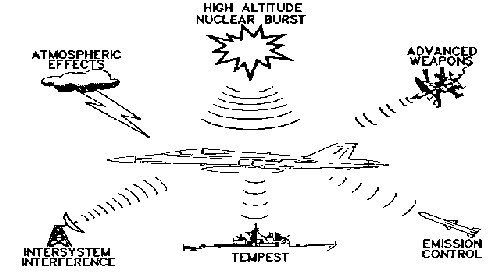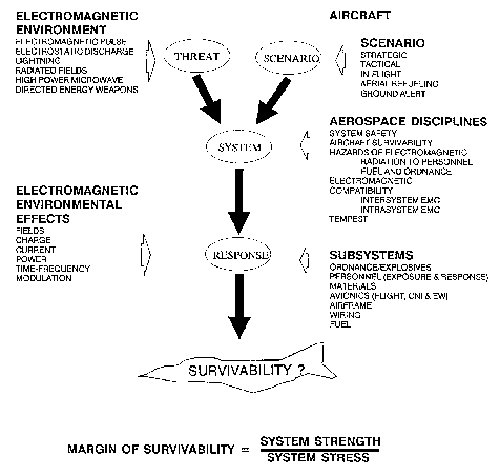
Figure 1 - The Electromagnetic Threat Environment
Unified EME in the World of Transient Phenomena
Mr. Sam Frazier
NAVAIRWARCENACDIV
Patuxent River, Maryland
Dr. Bruce C. Gabrielson
UIE
Leonardtown, Maryland
Abstract
This article reports the status of ongoing research efforts by the Naval Air Warfare Center, Aircraft Division, to significantly improve testing techniques associated with Electromagnetic survivability assessments on aircraft. With increasingly severe electromagnetic threat environments emerging, plus the problems inherent with budget reductions, the need to re-evaluate how aircraft survivability is determined becomes very important. In this regard, significant improvements in Electromagnetic Pulse (EMP) and other pulse type threat test and evaluation is possible, with no loss in efficiency, using existing data acquisition and processing capabilities and recently developed composite waveform direct-drive technology.
Introduction
Electromagnetic survivability involves the determination that various elements of the electromagnetic threat environment shown in Figure 1 will have no damaging or upset effects on the many parts of the system which has been exposed to this environment. In other words, overall survivability is dependent upon the interaction of various threats, scenarios, and system.

Figure 1 - The Electromagnetic Threat Environment
Each threat environment can have a unique waveform when it reaches the subsystem's sensitive electronics either directly or through some indirect coupling mechanism. In addition, the threat can exist as a field, charge, current, power source, or a modulated waveform, and each form can result, depending on the margin of survivability of the particular electronics, in different level responses from the system elements. This overall relationship between the electromagnetic threat environment, the discipline involved, and the aircraft is shown in Figure 2.

Figure 2 - The Threat-Scenario-System-Response Interaction
Why Unified EME?
The unification of the various EME disciplines into a consolidated overall set of threat levels, test requirements, and techniques has long been the goal of many individuals representing both DoD and industry. The cost advantages of reduced test equipment and test time, coupled with the substantial number of reduced test requirement documents, would be a significant step forward for the EME community. Unfortunately, each of the disciplines involved has unique characteristics such that only loose groupings of certain threat types are currently possible at either the box level or at the system level. For instance, while EMC and TEMPEST have similar (but different) approaches to radiated and conducted emission problems, no such similar comparison exists between EMP and either discipline. Even overall shielding has only limited usefulness in some TEMPEST applications. Therefore, while unification within certain subsets of EME has some advantages, complete EME unification may never be possible.
Table 1 and 2 show unreduced evaluation comparison matrixes for threats at both the box and system level. Notice the flow runs from top left to bottom right and from modulated signals to transients. Straight forward requirement and technique groupings could follow a similar pattern, particularly if EMC/EMI is considered an omnibus threat and eliminated from a first level reduction matrix. However, any reduction must involve a corresponding combination of threats, test requirements, and technology.

BOX LEVEL THREAT COMPARISON MATRIX
Table 1
The Need for Consolidation in Transient Threat Testing
A considerable amount discussion has taken place recently within EMP community regarding the need to "explore the feasibility of developing consolidated tests to replace individual threat tests[1]".
This need is consistent with the Defense Nuclear Agency's (DNA's) low-risk EMP hardening approach which provides the conceptual framework for pulse type threat protection within an overall unified electromagnetic environment (EME). The low-risk approach basically says provide a Faraday shield around everything and protect all penetrations. If applied correctly on an aircraft, the implications are that penetrations become the significant point for threat exposure, and that the possibility exists for the development of some unifying test approach to reduce the current need for the various separate electromagnetic environmental effects (E3) tests.
Any test approach used to support unified EME must be applicable for all transient environments, all aerospace disciplines, all effects and all responses. The concept of margin-of-survivability has been the backbone of the aircraft electromagnetic RDT&E for over 20 years, and the underlying principles upon which it is based remain sound. Therefore, a unified and upgraded EME test approach for electromagnetic transient phenomena which would better characterize coupling and more closely bind the system's margin of survivability while at the same time reducing the number of overall EME tests required fits well with the current needs and objectives of the EMP community.

SYSTEM LEVEL THREAT COMPARISON MATRIX
Table 2
Basic Measurement Approach
The basic approach for testing transient type effects on aircraft has been consistent for several years. This approach involves a two tier level of testing. First, the system is exposed to a simulated external transient threat environment, normally at a level below the actual threat, with measurements of the internal responses generated by the system measured at many locations. This response is considered the system stress, and sets the system level of susceptibility to the external threat. Inherent within the stress waveform is the transfer function for the system to the box level.
Next, while the system is operating, the same test point responses which were measured are recreated, amplified to near the extrapolated full threat level, and then reinjected at increasingly higher levels into the avionics equipment at the same test point until the system upsets, fails, or a reasonable safety margin above full threat is achieved. The level required to cause upset is considered the system strength, and the margin of survivability is defined as the system's strength divided by its stress.
The question becomes could this same approach, re-injecting some composite stress waveform incorporating several transient type threats, be useful in a unified EME test methodology. If a matrix reduction is performed on those box and system level threats involving transient phenomena, the result is shown in Table 3. Based on the reduced threat comparison matrix, direct injection testing may offer a partial solution.

BOX LEVEL REDUCED COMPARISON MATRIX
Table 3

SYSTEM LEVEL REDUCED COMPARISON MATRIX
Table 4
*Note: Once measured, the Radiated Emission from a box level measurement could be re-injected to a test item using direct drive.
**Note: Conducted Susceptibility could represent direct drive testing or re-injection testing based on measured values from a Radiated Susceptibility test.
The Stress Envelope Concept
Efforts have been underway for some time within the EMP Section at NAVAIRWARCENACDIV to reduce the inefficient near duplication of test efforts made necessary as a result of related, but currently independent threat sources. The approach has been to consider a holistic solution to the overall response problem. As was shown previously, the actual outcome of a given event is dependent upon the interaction of the threat, system, and scenario. Although each response is theoretically unique, a significant number of responses, especially from pulse type threats are similar, if not the same. Building upon these similarities, a unification approach based on the concept of the electromagnetic stress envelope is being investigated.
The electromagnetic stress envelope is the system's maximum internal electromagnetic response at a physical location to an external electromagnetic threat. Each element of the EME will generate certain system response characteristics, some of which are identical, and all of which can be modeled for all aircraft orientations, configurations, polarizations, etc. When the system resonances and threat characteristics at a particular point for each EME are combined in some way, they represent the total electromagnetic threat envelope, or the stress envelope for the entire system. The electromagnetic stress envelope can, therefore, be modeled and developed for any system level, from a test point to the entire aircraft. Figure 4 describes visually the unification approach to develop a combined stress envelope for the EMP threat to a particular aircraft.
Conclusion
Using similar combinatorial techniques, the same approach described could be used for lightning and ESD threats with the overall result combined to produce a total pulse threat waveform. This concept of developing composite waveforms from multiple measurements for use in direct-drive re-injection testing meets the unification objectives and may provide long term improvements to the current EMP, lightning, and ESD test methodology.
References
[1] DNA's EMP Hardening Approach Forms Basis for Unified Electromagnetic Effects Protection